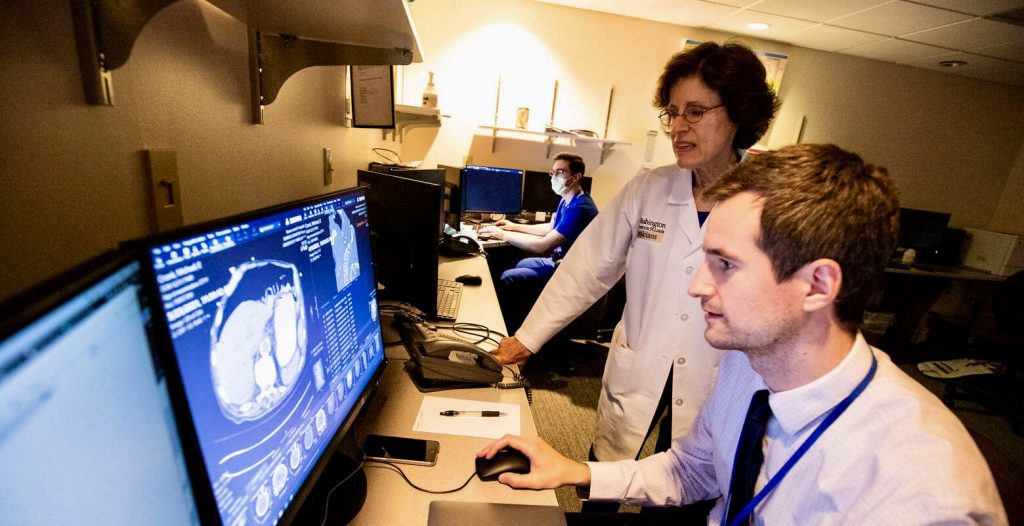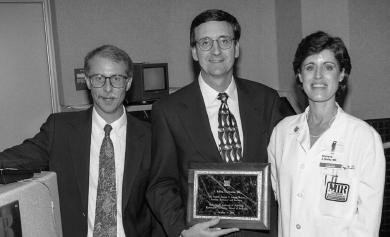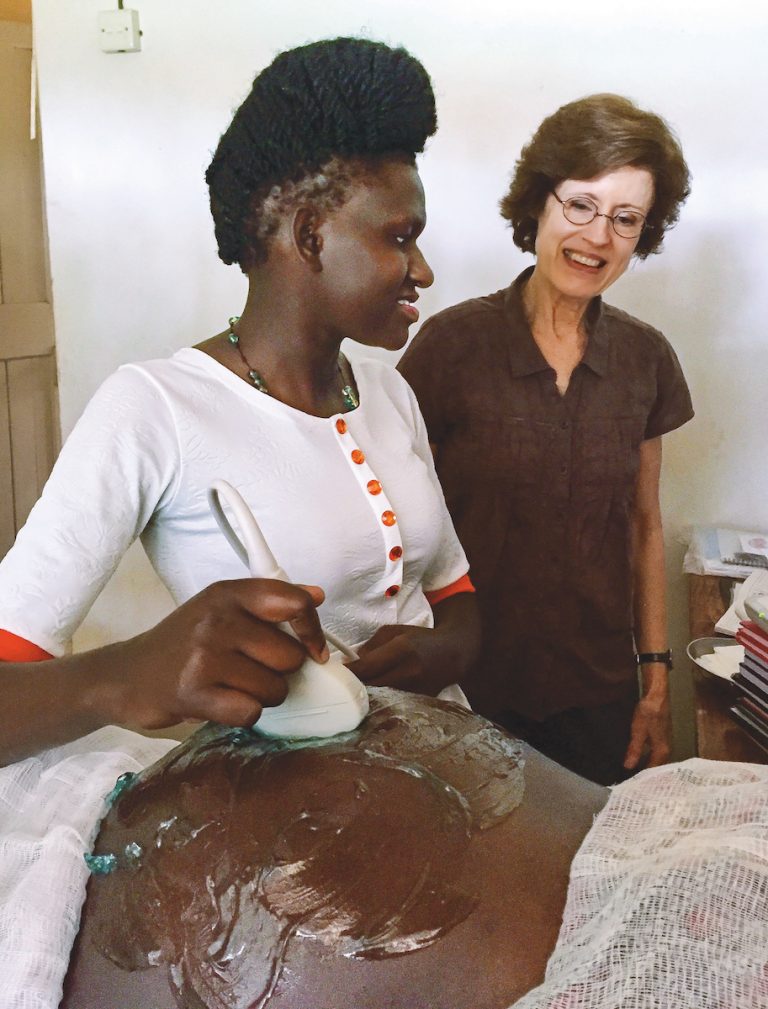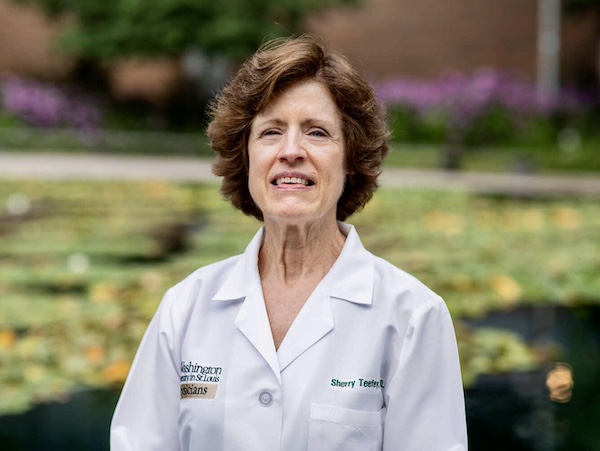From Washington University’s medical campus in St. Louis to the rolling hills of Uganda, Sharlene A. Teefey, MD, has dedicated her career to advancing and sharing the power of ultrasound to make a tremendous difference in the care and lives of patients.
Life-Changing Opportunities

When she first started out, Teefey could not afford medical school, so she earned a nursing degree instead. She took a position in the intensive care unit at the Straub Clinic, a private clinic in Honolulu. “They were using nurses almost like interns, because they had no residents,” she said.
At the encouragement of the clinic’s physicians, Teefey started taking pre-med classes at the University of Hawaii. There, she met Ben Young, MD, a psychiatrist at the university’s school of medicine and the mentor who changed the course of her life. Young had just launched a one-year pre-med training program called ‘Imi Ho‘ōla, Hawaiian for “those who seek to heal.” ‘Imi Ho‘ōla provides aspiring physicians who are underrepresented in medicine, such as Pacific Islanders and women, with the preparation needed for medical school. Teefey and her colleagues in the program’s third cohort became like family and, after nearly 50 years, remain very close.
While attending the University of Hawaii School of Medicine, Teefey spent two months in her fourth year of medical school at a hospital in the South Pacific on the island of Pohnpei, a U.S. trust territory at the time. “I had never seen such poverty,” she said. “That’s when I promised myself that I would circle back at some point to pay it forward and give others with the same opportunity I had: to improve the quality of their lives through education. She now supports four children and five young adults in school in Uganda (one is in medical school) and a kindergarten for Pygmy children in Congo.
An Ultrasound Pioneer
Teefey discovered her passion for radiology during her fourth year of medical school while participating in an exchange program at the University of Utah. “A radiologist took us under his wing and showed us what radiology could do,” she said. “Fireworks were going off in my head and I thought, ‘This is what I want to do.’”

She had started an internal medicine residency at the Mayo Clinic in Rochester, Minn., but switched to radiology in her second year. “I thought about my experiences in Hawaii and Pohnpei and realized that ultrasound would be an ideal imaging tool for me to use my skills to give back to others.”
In 1992, while working at the University of Washington in Seattle, Teefey was recruited by Dennis M. Balfe, MD, to join the faculty at MIR, making her the first woman in the abdominal imaging section. “The friendliness and camaraderie at Mallinckrodt reminded me of what I experienced in Hawaii,” she said. “I just felt at home.”
She was drawn to abdominal imaging because “it involved so many different organ systems,” she said. “And ultrasound gave me the opportunity to talk directly to patients to better understand their symptoms and make the correct diagnosis.”
Teefey continually honed her scanning skills and began to do research in partnership with her ultrasound colleague William D. Middleton, MD. They initially worked with the orthopedic shoulder surgeons and collaborated on several studies to show the pivotal role of ultrasound in evaluating rotator cuff tears. They also pursued research in thyroid ultrasound, working with a group of radiologists to develop a method for scoring thyroid nodules that has become widely adopted.
During the COVID-19 pandemic, Teefey and Middleton worked with immunologist Ali Ellebedy, PhD, to biopsy axillary lymph nodes to study their response to mRNA vaccines. That work was published in the journal Nature. All told, Teefey has contributed to more than 140 research publications. “Dr. Teefey has established a legacy as one of the pioneers of ultrasound research and ultrasound as a clinical subspecialty,” said Vincent M. Mellnick, MD, chief of the abdominal imaging section.
Improving Maternal Health and Lives
In 2013, Teefey started working with a St. Louis-based nonprofit called Microfinancing Partners in Africa (MPA). MPA works in six countries in eastern and southern Africa. The organization empowers women to lift themselves out of poverty through microfinancing projects such as animal husbandry and small retail businesses.

While in Uganda in 2016, Teefey was asked to address the high incidence of obstetric fistula, which is caused by obstructed labor. Obstructed labor is a significant source of maternal and fetal mortality; if the mother survives, she leaks urine and stool and is shunned. MPA’s Safe Birth Project, launched in 2017, joined ultrasound, obstetric fistula education and microfinancing to address this challenge. Portable ultrasound machines have been placed at 22 village health centers, and midwives have been trained to identify three high-risk obstetric conditions — placenta previa, transverse lie and twins — that would mandate referral of the pregnant mother to a health facility with an obstetrician. Recent data shows a rise not only in the number of antenatal visits to the village health centers but also in deliveries because of the project.
According to Teefey, a village health center supervisor recently stated that the project is decreasing maternal and fetal mortality in the community. “Dr. Teefey’s combination of pure philanthropy and using her expertise in her specialty area in an underserved part of the world is just incredible,” said Mellnick.
Teefey, who received the 2020 Distinguished Community Service Award from the School of Medicine for her volunteer work in Africa, now devotes a significant amount of her time to the Safe Birth Project. She visits Uganda twice a year and plans to expand the project there and hopes to bring it to other countries. “What we’ve accomplished has fulfilled my dreams beyond expectation,” she said. “I am humbled to be a part of this project and grateful to MPA for the opportunity to bring it to fruition.”
Published in Focal Spot Winter 2024 Issue

